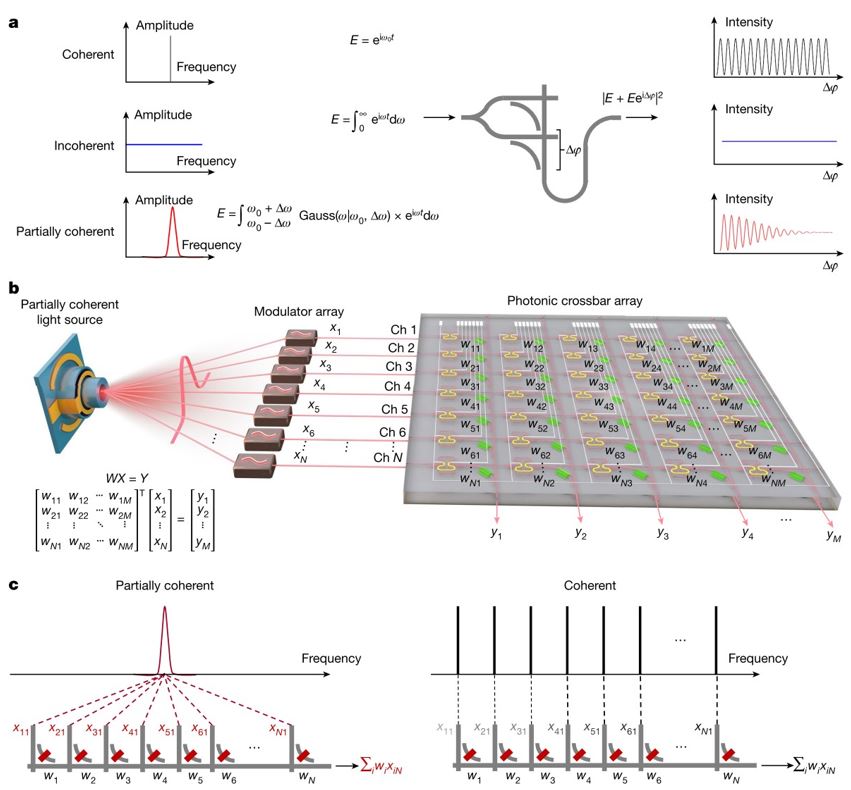|
— 资料提供:影像显示科技知识平台 (DTKP, Display Technology Knowledge Platform) —
— 整理:林晃岩教授、郭权锋 —
低同调光增强光子计算
同调光对于光子计算的应用相当广泛,例如光达(Laser Imaging Detection And Ranging , LIDAR)、长距离光通信和光学同调断层扫描(Optical Coherence Tomography, OCT)。同调光还可用于光子计算,因为其相位一致性确保了稳定和可预测的计算结果。然而,这需要透过整合型热相移器(thermal phase shifters)精确控制光的相位,这不仅增加了功耗,还需满足对温度和频率的稳定性需求。
藉由掺铒光纤放大器(Erbium-doped fiber amplifier, EDFA)的滤波产生低同调光,均匀分配至N个输入信道,每个信道的振幅进行调变以形成N个输入向量单元(如图一)。该输入向量接着被传送至具有加权单元的芯片以执行矩阵计算。相比之下,同调系统需要波长多任务技术,要求N个独立的光学频段来实现同样的N个向量单元,并避免不必要的干扰。因此,非同调方法能够提高平行化程度,因为在单一频段内可以同时执行比同调系统多N倍的运算。
|

|
|
图一、部分同调增强平行光子计算的概念。(a) 当使用同调光、非同调光或部分同调光源时,在单一计算单位单元格的乘法与加法操作中,随着相位差 ∆φ 增加而产生的强度变动,Gauss(ω|ω0,∆φ) 表示以平均值ω0和标准差∆ω的高斯分布。(b) 使用部分同调光进行平行光子计算的工作原理。(c) N倍的平行化增强,N为输入向量的维度。
|
芯片上的加权组件可以是任何能进行振幅调变的光子组件。作者在两种情境下展示了该方法的应用。在第一个示例中,他们使用一个含有相变材料(phase-change materials, Ge2Sb2Te5和氧化铟锡堆栈)的整合电路,实现具备3 x 3张量核心的平行卷积处理。此架构能以92%的准确度对帕金森氏症患者的步态(gait)进行分类。在第二个示例中,作者实现了一个由比利时校际微电子研究中心(Inter-university Microelectronic Centre, IMEC)制作的硅基平台卷积处理器,并整合光检测器。该处理器的运算速度最高可达每秒0.108兆次运算(TOPS),并以92.4%的准确度分类数据集(Modified National Institute of Standards and Technology database, MINST)(如图二)。
|

|
|
图二、MNIST手写数字数据集的高速卷积处理。(a) 9×3光子电致光吸收调变器 (Electro-absorption modulator, EAM) 张量核心的照片。输入光源为8.0 nm带宽的部分同调光。尺度为100 µm。(b) 连接的光子EAM张量核心的模块照片,蓝色框表示(a)中所示区域。(c) 使用Sobel Gx和Sobel Gy 滤波器进行数字“0”的边缘检测。(d)(e) 使用部分同调系统进行卷积的准确性,分别为不进行平均处理(d)和四点平均处理(e)。在(d)和(e)中共比较了100,000组预期和测量结果。插图显示了归一化误差的高斯分布。(f) CNN架构。(g) CNN分类结果的比较。
|
此策略透过减少系统需求(通常包括昂贵的高性能激光),有望实现更经济且节能的光子计算。透过提供这些替代方案,该方案可降低光子计算架构发展时的经费支出和能耗需求。
|
参考资料:
|
Pitruzzello, G. "Low-coherence light enhances photonic computing," Nat Photon 18, 1009 (2024)
https://doi.org/10.1038/s41566-024-01536-6
DOI:10.1038/s41566-024-01536-6
|
|
参考文献:
|
Dong, B., Brückerhoff-Plückelmann, F., Meyer, L. et al. "Partial coherence enhances parallelized photonic computing," Nature 632, 55-62 (2024)
https://doi.org/10.1038/s41586-024-07590-y
DOI:10.1038/s41586-024-07590-y
|
|